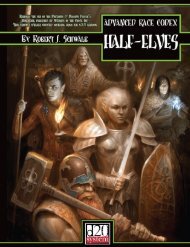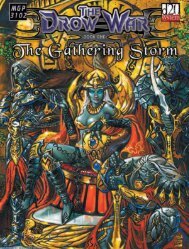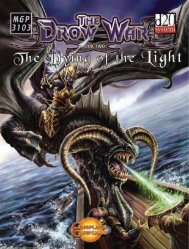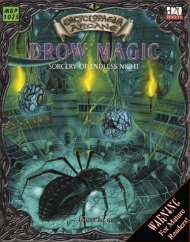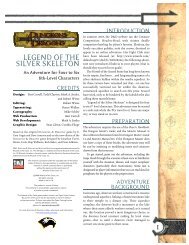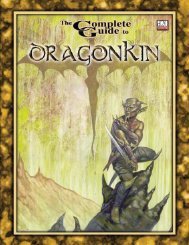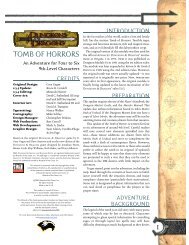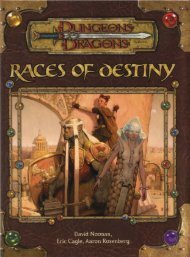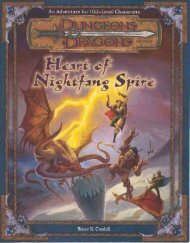Create successful ePaper yourself
Turn your PDF publications into a flip-book with our unique Google optimized e-Paper software.
190<br />
Scrolls<br />
Roll Effect<br />
1-16 Scroll functions as intended<br />
17-18 Scroll is gibberish<br />
19 Scroll is cursed<br />
20 Explosive runes<br />
Effect Descriptions for Potions<br />
� Potion functions normally: <strong>The</strong> potion is in all ways<br />
indistinguishable from one created without the lifebinding<br />
ritual.<br />
� Potion functions normally, but with additional unwanted<br />
effect: Essentially, the potion works as planned (a<br />
potion of cure light wounds, for example, will heal hit<br />
point damage). However, there is some unplanned and<br />
unwanted side effect which accompanies the potion’s<br />
function, such as causing the imbiber’s hair to fall out<br />
or changing the colour of his skin. <strong>The</strong>se side effects<br />
are minor, and do not directly damage the caster (though<br />
a drow whose skin turns pale may soon have a host of<br />
other problems). <strong>The</strong>se effects may be undone with<br />
dispel magic or remove curse.<br />
� Potion is inert: <strong>The</strong> potion is simply a phial of oddly<br />
coloured, foul-tasting liquid with no magical properties<br />
whatsoever. This can be determined before drinking by<br />
casting detect magic.<br />
� Poison I: Ingested poison, DC 11. Initial damage 1<br />
Con, secondary damage 1d6 Con<br />
� Poison II: Ingested poison, DC 15. Initial damage 1d4<br />
Int, secondary damage 1d4 Con, 1d4 Int<br />
� Poison III: Ingested poison, DC 20. Initial damage 1d6<br />
Wis, secondary damage 1d6 Wis, 1d6 Int. This poison<br />
cannot be detected by the detect poison spell.<br />
Scrolls<br />
Like potions, scrolls are rarely created through lifebinding,<br />
for much the same reasons. However, it is not unknown<br />
for a wiza rd or a temple with the need to create a large<br />
number of scrolls as soon as possible to shepherd dozens<br />
of unwilling slaves onto the sacrificial altar to aid in the<br />
fabrication of the needed scrolls.<br />
Effect Descriptions for Scrolls<br />
� Scroll functions as intended: <strong>The</strong> scroll is in all<br />
ways indistinguishable from one created without the<br />
lifebinding ritual.<br />
� Scroll is gibberish: <strong>The</strong> scroll is an insane mess of lines<br />
and characters that mean nothing, and certainly cannot<br />
be used to cast a spell.� Potion is inert: <strong>The</strong><br />
potion is simply a phial of oddly coloured, foul-tasting<br />
liquid with no magical properties whatsoever. This<br />
can be determined before drinking by casting detect<br />
magic.<br />
� Scroll is cursed: <strong>The</strong> scroll functions, but in a way<br />
totally opposite of the reader’s wishes. For example,<br />
a scroll of fireball would create a fireball that burst in<br />
the same square as the reader, rather than travelling to<br />
the intended target. Likewise, a scroll of heal would<br />
actually inflict harm on the target. It is impossible to<br />
tell the scroll is anything other than what it was intended<br />
to be until it is read and the curse manifests.<br />
� Explosive runes: <strong>The</strong> scroll has no spell on it, merely<br />
explosive runes that detonate as a maximised spell upon<br />
reading.<br />
Armour and Weapons<br />
Armour and weapons are among the most common items<br />
created through lifebinding, but due to the number of things<br />
that can go wrong with them, it is usually only the most<br />
accomplished and powerful drow spellcasters who feel<br />
comfortable creating them for their own use. More often,<br />
armour and weapons created by lifebinding an unwilling<br />
sacrifice are given to servants or sold.<br />
Effect Descriptions for Armour and Weapons<br />
� Item functions as intended: <strong>The</strong> armour or weapon is in<br />
all ways indistinguishable from one created without the<br />
lifebinding ritual.<br />
� Item is non-magical: <strong>The</strong> experience points invested in<br />
the item by both the sacrifice and the caster are lost,<br />
leaving only a non-magical item. <strong>The</strong> item is still<br />
considered enchantable, if the spellcaster wishes to try<br />
again.<br />
� Item has a drawback: <strong>The</strong> resistance of the sacrifice has<br />
altered the enchantment of the item in some minor way.<br />
Roll on the drawback table (see DMG) to see what<br />
effect manifests.<br />
� Item has half the expected effect: <strong>The</strong> ‘plus’ of the<br />
armour or weapon is only half of what was intended.<br />
For example, a spellcaster attempting to make a +2<br />
longsword with lifebinding will find it is only a +1<br />
longsword. <strong>The</strong> item’s cost in gold and experience,




